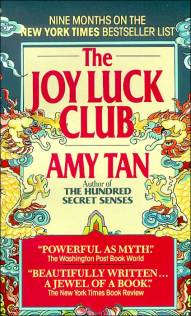 Amy Tan’s “The Joy Luck Club” follows four Chinese American immigrant families living in San Francisco who created the Joy Luck Club. In 1949, four Chinese women begin meeting to eat dim sum, play mahjong and talk with the aim of raising their spirits as well as their money. As Suyuan Woo tells her daughter June: “To despair was to wish back for something already lost. Or to prolong what was already unbearable.”
Amy Tan’s “The Joy Luck Club” follows four Chinese American immigrant families living in San Francisco who created the Joy Luck Club. In 1949, four Chinese women begin meeting to eat dim sum, play mahjong and talk with the aim of raising their spirits as well as their money. As Suyuan Woo tells her daughter June: “To despair was to wish back for something already lost. Or to prolong what was already unbearable.”
Amy Tan uses the four mothers and their daughters to tell their perspective. As the Amazon.com summary says, “four mothers, four daughters, four families whose histories shift with the four winds depending on who’s “saying” the stories.”
It’s been a week and a half since I finished reading “The Joy Luck Club” by Amy Tan. I started it on the train ride back from Boston, and finished in the Philadelphia airport waiting to fly back to Chicago. So why haven’t I written and posted my review before now? I have no good answer because I really enjoyed the book. It’s been on my list since I read the first chapter for a creative writing class a couple of years ago.
Many of the issues brought up — namely the disconnect between the first generation Chinese mothers and the second generation Chinese American daughters — reminded me a lot about what I learned in my capstone reporting class, Mosaic. In that class, we reported on the immigrant community in Lincoln, Omaha and across Nebraska. As I read each chapter, I wondered if I should’ve read this book a year ago when I was writing my stories for the class (not that I had the time, unfortunately).
One thing I find difficult in my own fiction writing is separating the voices of the different characters. But Tan does a wonderful job creating a different voice for each mother as well as the daughters. Not only that but also the daughters had a similar tone to their mothers’ as well — that was how I really separated the different narratives when my Kindle wouldn’t flip back to the list of names fast enough for me.
I also loved reading the little nuggets of wisdom or truth. They would catch me off guard a little bit; I’d go back and reread the line a couple of times before I highlighted the quote and moved on to the next page.
That is the way it is with a wound. The wound begins to close in on itself, to protect what is hurting so much. And once it is closed, you no longer see what is underneath, what started the pain. (38)
But she never looked back with regret. There were so many ways for things to get better. (139)
There were many self-empowering moments within each vignette as well. One of my favorites was in “The Red Candle,” Lindo Jong’s vignette. In it, she tells of how she had an arranged marriage with a boy from a richer family. Just before the ceremony, she was crying and thinking bitterly about her parents’ promise, about why her destiny had been decided this way. She asked herself what is true about a person and if she would change “in the same way the river changes color but still be the same person”? It was then she realized that it was the first time she could see the power of the wind.
“I wiped my eyes and looked in the mirror. I was surprised at what I saw. I had on a beautiful red dress, but what I saw was even more valuable. I was strong. I was pure. I had genuine thoughts inside that no one could see, that no one could ever take away from me. I was like the wind.” (51)
There are so many things I loved about “The Joy Luck Club.” This was one of the books where I found myself wondering why I hadn’t read it sooner, why I hadn’t read it in high school. It’s one of the books I think every woman should read. Seeing the two different generations interact and tell their own stories through chapter vignettes is very powerful. Perhaps I’ll try to mimic that in my own writing some day.
So we decided to hold parties and pretend each week had become the new year. Each week we could forget past wrongs done to us. We weren’t allowed to think a bad thought. We feasted, we laughed, we played games, lost and won, we told the best stories. And each week, we could hope to be lucky. That hope was our only joy. And that’s how we came to call our little parties Joy Luck. (9)